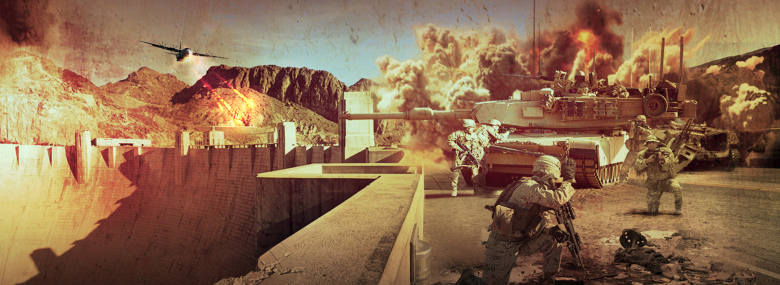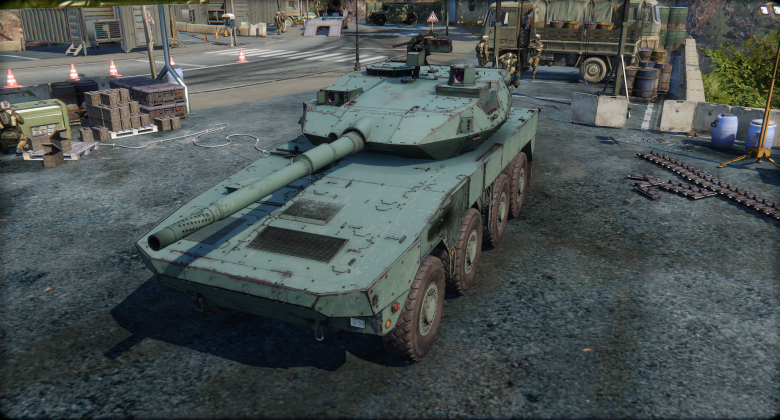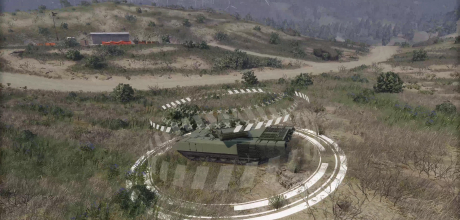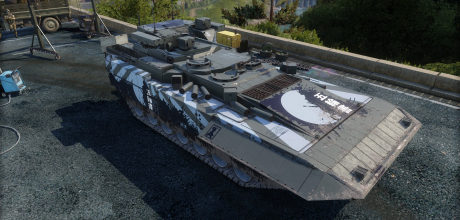
Commanders!
The New Year celebrations are over – even in Russia – and we are, once again, hard at work bringing you a lot of exciting content that’s going to appear in Armored Warfare in 2020. In the first quarter of this year, we’d like to launch another, Asian-themed season called Spirithaven and, today, we’d like to show you the first of the progression vehicles that are coming with it – the Type 16 Maneuver Combat Vehicle.

Type 16 MCV
Ever since 1945, Japan’s military force has become practically exclusively defense-oriented and tasked with the protection of its mainland. Only in the recent years, discussions have begun about changing some elements of that concept, but the Second World War had a profound impact on the way Japan sees its army and its mission.
In order to understand the concept behind the creation of this vehicle, one has to have two things in mind.
The first thing is that Japan is essentially a mountainous country. In the event of an invasion, fighting in difficult terrain would be unavoidable and there are very few tanks that are suitable for such a task. This is one of the main reasons why Japan has been developing MBTs with hydraulic suspension that can help depress or elevate their main weapons beyond the limits normally allowed by their turrets. When tanks have to aim up and down the slopes to repel an attack, every degree would help.
Secondly, weight also plays a major role in such environments. Truly heavy MBTs would struggle getting into position through narrow mountain passes or across various bridges (that’s why many Japanese MBTs tend to be on the lighter side). A lighter vehicle (ideally one that could be transported by air) with the firepower of an MBT would therefore be actually more sensible than a sixty-ton category tank.
And that’s essentially the rationale behind the Type 16 MCV. The Japanese created an agile wheeled tank that is very suitable for the Japanese terrain. It lacks the protection of a tank, but features very advanced electronics and optics, allowing it to ambush its enemies, leaving them battered and retreat to safety after the action.

Type 16 Prototype
The development began perhaps as early as in 2007 by the Technical Research & Development Institute of Japan’s Ministry of Defense. The first prototype was ready by 2008, and between 2009 and 2014, several extensive rounds of testing took place. After their successful conclusion, in 2016, the vehicle was accepted in service under the name of Type 16 Maneuver Combat Vehicle.
The Type 16 MCV weighs 26 tons and has a crew of four since its main weapon is manually loaded. In order to keep its weight this low, the vehicle is only lightly armored with same type of modular welded multi-layer steel armor the Type 10 MBT uses. According to some sources, it is nano-crystal steel with high matrix density, incorporating some non-metallic elements (carbon) – something between an alloy and a composite.
Regardless, in its most basic for, it offers protection from small arms only (STANAG 4569 Level 3) with particularly low resistance to mines and IEDs – despite its light (“colonial”) nature, this vehicle is not meant for asymmetric combat abroad or anything like that and you generally don’t need to encounter mines in defensive actions. However, some sources have noted various planned or developed armor upgrades that would make the front of the vehicle resistant to 20mm or 30mm autocannons or even RPGs.
Additional protective measures include:
- 76mm smoke grenade launchers
- Laser warning system
- Automatic fire extinguisher
Where this vehicle truly shines is mobility. It is powered by a 570hp Mitsubishi 4-cylinder turbocharged diesel, allowing it to go as fast as 100 km/h. It is also transportable by the Japanese Kawasaki C-2 transport planes, further adding to its strategic value, since it can be deployed anywhere across Japan in short order. It is also quite agile, albeit some sources claim that its off-road characteristics leave much to be desired for. Indeed, wheels are worse off-road than tracks and the Type 16 MCV was clearly designed with roads in mind rather than bogs or forests – the Type 16 MCV is not amphibious.

Click the image to open a larger version
The firepower consists mainly of its 105mm Japanese Steel Works L/52 rifled gun. This weapon is roughly similar in performance to the Royal Ordnance L7 and can fire the same NATO standard ammunition, but it is not (contrary to popular belief) its copy – it was developed indigenously in Japan using special alloys and processes. The ammunition it can fire includes:
- JM33 APFSDS (460mm of penetration at 2km)
- Type 93 APFSDS (460-500mm of penetration, depending on sources)
- Type 91 HEAT-MP
- Type 75 HEP
Like it was mentioned above, the gun is loaded manually, allowing for the rate of fire of roughly 8 rounds per minute. Its maximum elevation is +15 degrees and its depression is -6 degrees, although these values are estimated only from various photos and are not openly stated anywhere.
The gun is fully stabilized and features both a thermal shroud and a muzzle reference system. It is paired with an advanced fire control system similar to the one used in the Type 10 MBT. It includes a Thales weather sensor and a hunter killer capability (where the gunner can engage one target while the commander already searches for another one and designates it for the gunner). The gunner has the following tools at his disposal:
- Day/night sights
- Thermal imager
- Laser rangefinder
The commander, on the other hand, has the access to his own:
- Panoramic day/night sights
- Thermal imager
- Laser rangefinder
Between 2016 and 2019, 109 vehicles of this type were built by Mitsubishi Heavy Industries and most are intended to be deployed to Kyushu (the southernmost Japanese island). This reflects the shift in Japanese defensive policies. One of the biggest problems for Japan is the fact that they have a limited number of tanks available and their tanks are very expensive. Replacing some of them – especially the aging Type 74 MBTs that are scheduled to be phased out in the near future – with Type 16 MCVs would make for a cost-effective solution.
The deployment to Kyushu is connected to the threat shift – instead of the defunct Soviet Union, Japan now has the Chinese ambitions in the East China Sea to contend with. The behavior of China – an emerging superpower and regional hegemon – is therefore likely to dictate the defensive strategies of all other countries in the area for years to come and since Kyushu is the first and most obvious target at hand for any potential invader, it makes sense to deploy the bulk of these vehicles there. From there, they can be air-transported easily to the other regions of Japan.

Click the image to open a larger version
In Armored Warfare, the Type 16 MCV will be a Tier 7 progression Tank Destroyer, available through a new dealer we’ll be implementing in Update 0.31. Just like with the American Dream branch of U.S. vehicles, the Type 16 and its branch will be unlockable from already existing machines – in this case, either the C13 TUA TD (Francine De Laroche) or the Type 90-II MBT (Zhang Feng).
At first glance the Type 16 will be comparable to a Centauro – the concept is the same: light wheeled fire support vehicle with a 105mm rifled gun, even though the weapons are somewhat different.
With its ingame weight of 26 tons and its Mitsubishi 570hp engine, the Type 16 will be fairly mobile and about equal to the Tier 7 Centauro. The same goes for its armor – it will protect the vehicle frontally only from 30mm autocannons or smaller weapons and the flanks will be even more vulnerable, making it clear that this vehicle should not enter close combat under any circumstances.
Things will start to get really interesting when we look at this Tank Destroyer’s firepower and special abilities. The Type 16 MCV will be armed with a Japanese Steelworks 105mm rifled gun, comparable in performance to the famous NATO standard 105mm L7. This manually loaded gun will fire all sorts of shells, including APFSDS, HEAT, HESH and even the LAHAT HEAT-MP guided missiles. With its solid penetration (up to 650mm for the upgraded APFSDS) and damage output (reload time 4 seconds), it’ll be an effective second line Tank Destroyer.

Click the image to open a larger version
But its true strength will lie in convenience – or, more specifically, the ease with which it will be able to hit its targets. For starters, the gun will be very accurate while moving and will have solid depression and elevation levels (-6/+15 degrees). However, that’s still not all.
The tank will feature a very special mechanism called AI Target Assistant. This ability will work both in automatic and manual aiming modes.
In the automatic mode, normally, marking targets with right click will automatically aim your gun at the center of the target and keeps it locked there. In addition to that, the Type 16 autoaim will also “lead” the target – if the target is, for example, moving from right to left from the Type 16 gunner’s point of view, the gun will aim ahead of the target so that when the trigger is pressed, the shell will fly towards where the target is going to be at the time it will cross its trajectory.
In the manual mode where you control the gun, you will see a marker indicating where to aim to hit the target moving on its current trajectory.

Click the image to open a larger version
While not as effective at close ranges, this mechanism will make long range shot adjustments easier, allowing the Type 16 to snipe more effectively. In addition to that, the vehicle itself will be fairly stealthy (32% camouflage factor) and equipped with excellent optics (410m view range), upgradeable further with a thermal imager.
Overall, what we have here is a dedicated gun sniper that will be able to take some trick shots thanks to its advanced systems and a perfect launching vehicle for the fairly diverse progression branch. It’s also worth noting that the Type 16 MCV wasn’t chosen randomly – it was selected based on your feedback from 2019 when it was one of the most popular suggestions for the upcoming branch.
We hope you’ll like it.
See you on the battlefield!








